Meek Mars and a Nova in Evening, Prominent Predawn Planets, and a Leaving Moon lets Leo Launch Galaxy Season!
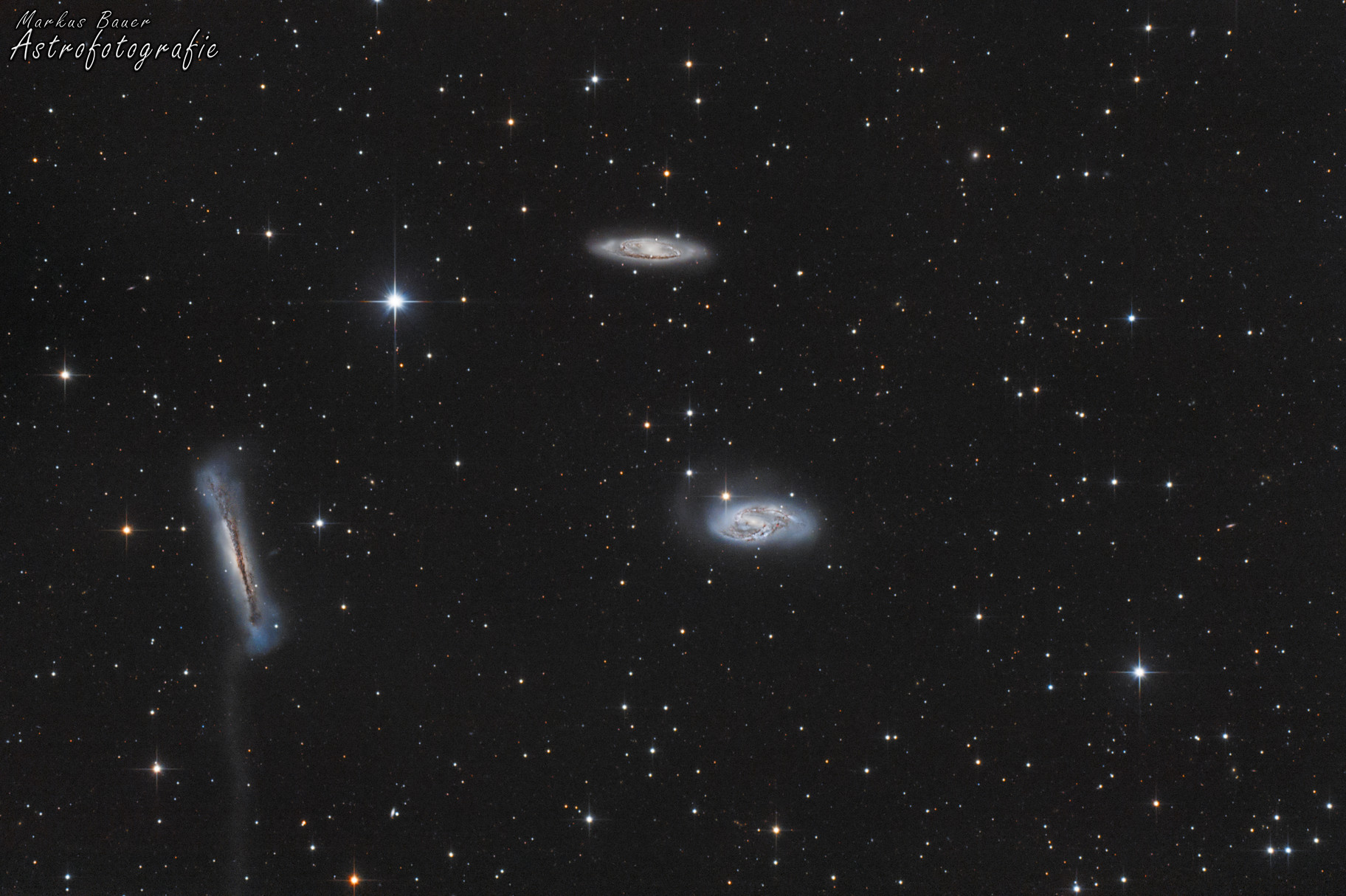
This image of the LeoTrio of Galaxies was captured by Marcus Bauer. It was a NASA APOD for April 18, 2019. Top to bottom, the image spans one degree of the sky. The Hamburger Galaxy (NGC 3628) is at centre left. Messier 65 is at top centre and Messier 66 is at centre right. The group, located two finger widths southeast of the bright star Chertan in Leo, is visible in medium-sized telescopes under dark skies.
Hello, End-of-March Stargazers!
Here are your Astronomy Skylights for the week of March 28th, 2021 by Chris Vaughan. Feel free to pass this along to your friends and send me your comments, questions, and suggested topics. You can also follow me on Twitter as @astrogeoguy! Unless otherwise noted, all times are expressed in Eastern Time. To subscribe to these emails please click this MailChimp link.
I can bring my Digital Starlab portable inflatable planetarium to your school or other daytime or evening event, or teach a session online. Contact me through AstroGeo.ca, and we’ll tour the Universe, or the Earth’s interior, together!
A nova has flared in Cassiopeia. The moon has peaked in brightness for this month and will move into the post-midnight sky while it wanes in phase this week – delivering stargazers around the world nice dark evening skies as galaxy-viewing season begins. To get you ready, I tour you through Leo. In evening, Mars is forming a triangle with its two “twins” Aldebaran and Betelgeuse – and the gas giant planets are prominent in the eastern pre-dawn sky. Read on for your Skylights!
Evening Zodiacal Light
If you live in a location where the sky is free of light pollution, you might be able to spot the Zodiacal Light, which will most apparent during the two weeks that precede the new moon on Monday, April 12. Starting at the end of evening twilight you’ll have about half an hour to check the west-northwestern sky for a wedge of faint light extending upwards from the horizon and centered on the ecliptic (i.e., below Mars and the Pleiades Cluster). That glow is sunlight scattered from countless small particles of material in the plane of our solar system – some possibly stripped from Mars by the Solar Wind. I posted a nice photo of the zodiacal light here.
The Moon
The moon officially reaches its full moon phase at 2:48 pm EDT today (Sunday). That corresponds to 18:48 Greenwich Mean Time. By the time the moon rises in the Americas at about 8 pm local time tonight, it will already look slightly past full – flattened a little bit on the right-hand (lunar eastern) side. A look through binoculars or a telescope will show that the craters along that rim of the moon already have shadowed edges.
Last week here I described the various names assigned to the March full moon and how this first full moon after the March equinox timed the beginning of Passover at sundown on Saturday, March 27 and Easter this coming weekend. This is also the first of four consecutive supermoons or lunar perigee syzygies, in 2021. Supermoon is an informal nickname coined to describe a moon that is full while it is also closer to Earth (perigee) – making it shine a little brighter and show a slightly larger diameter. That happens about every 14 months. The synchronization builds, peaks, and then decreases – so we get three or four supermoons in a row, one of which is “most super”.
During that same block of time, the new moon phases are happening at apogee, when the moon is farthest from Earth. Normally, we wouldn’t care about that, or even be aware of it. But May 26th’s biggest supermoon of 2021 will be followed two weeks later by a very small new moon, on June 10. That moon will be too small to completely hide the sun during a solar eclipse occurring on that morning – so parts of Northern Ontario and Québec, plus the North Pole and Northern Siberia will be treated to an annular solar eclipse! Stay tuned for more information about viewing the partial eclipse, which will be visible from eastern North America, the North Atlantic, and most of Europe and Asia. University of Toronto’s Dunlap Institute and Discover the Universe are providing free eclipse viewers! The link is here on their eclipse page.
Sunday night’s waning full moon will rise among the stars on Virgo (the Maiden) shortly before 8 pm local time. In this post from February, I wrote in detail about the many features that you can view on any full moon. The moon will continue its eastward journey through Virgo on Monday night, and then it will spend Tuesday and Wednesday night in Libra (the Scales). As the week wears on, the moon will be waning in phase and rising later and later – providing stargazers around the world with several hours of dark skies during mid-evening!
From Thursday to Sunday, the moon will journey through the summer constellations of Scorpius (the Scorpion) and Sagittarius (the Archer) – but you’ll need to get outside before dawn to see them. The moon will officially reach its third quarter phase at 6:02 am EDT (or 1:30 GMT) on Sunday, April 4. At third quarter our natural satellite always rises in the middle of the night and remains visible in the southern sky all morning. The moon will appear half-illuminated, on its western side – towards the pre-dawn sun. The ensuing week of moonless evening skies all over the world will be ideal for observing deep sky targets.
The Planets
Only one planet is easily visible during evenings nowadays. This week, Mars will continue its trek eastward between the horns of Taurus (the Bull). Two weeks ago it passed relatively close to its “twin”, Taurus’ bright reddish star Aldebaran. Now, Mars is positioned well above that star. Over the next two weeks Mars and Aldebaran will join the bright reddish star Betelgeuse in Orion (the Hunter) to form a large triangle.
Once the sky darkens shortly after 9 pm local time, the little reddish dot of Mars will be located halfway up the western sky – above and between Aldebaran (on its lower left) and the bright little Pleiades star cluster (on its lower right). Betelgeuse will sit two fist diameters to Mars’ left (or 22° to the celestial southeast). Mars will climb about a finger’s width farther from Aldebaran each night, and set after 1 am local time.
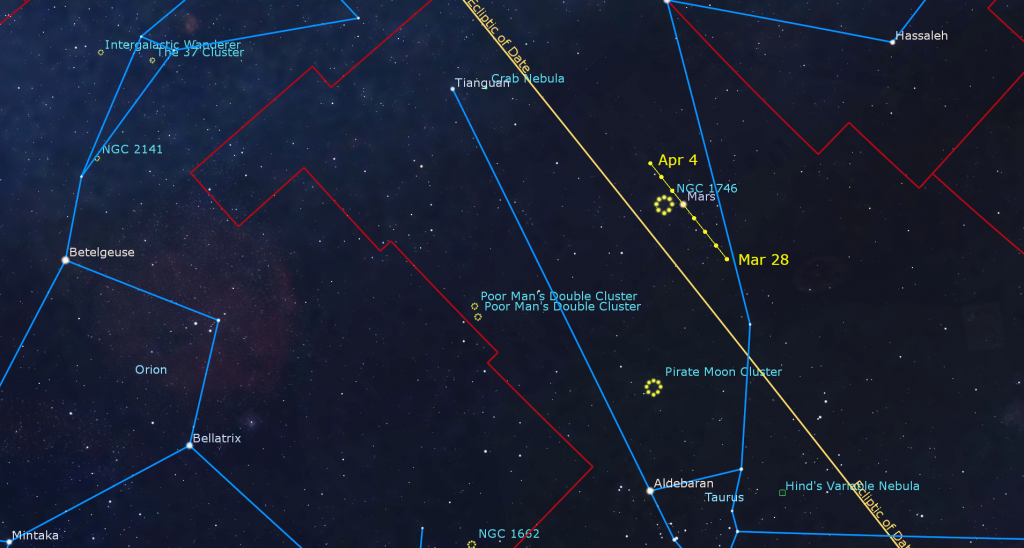
On Friday evening, Mars will move closely past a large open star cluster designated NGC 1746. That cluster sits between the bull’s horns. The planet will be close enough to the star cluster to see them together in binoculars on the surrounding evenings. At closest approach on Friday, Mars will be positioned just to the upper right (or to the celestial north) of the cluster’s edge, allowing the pair to be viewed at the same time in a backyard telescope. (Note that your telescope might flip and/or mirror-image their arrangement.)
Saturn and Jupiter are both among the dim stars of Capricornus (the Sea-Goat) in the southeastern pre-dawn sky. Because the sky will still be dark for a while after they rise, they’ll be quite easy to see before dawn – if your horizon is free of obstructions. Saturn clears the horizon by about 4:45 am local time. Much brighter will Jupiter join the ringed planet about 30 minutes later, sitting a generous fist’s diameter to Saturn’s lower left (or 11.5° east).
It will be too low in the sky for clear views of Jupiter in a telescope, but on Saturday morning, April 3, the round, black shadow of Jupiter’s moon Callisto will be crossing Jupiter’s disk, along with the Great Red Spot, between about 5:50 am EDT and dawn.
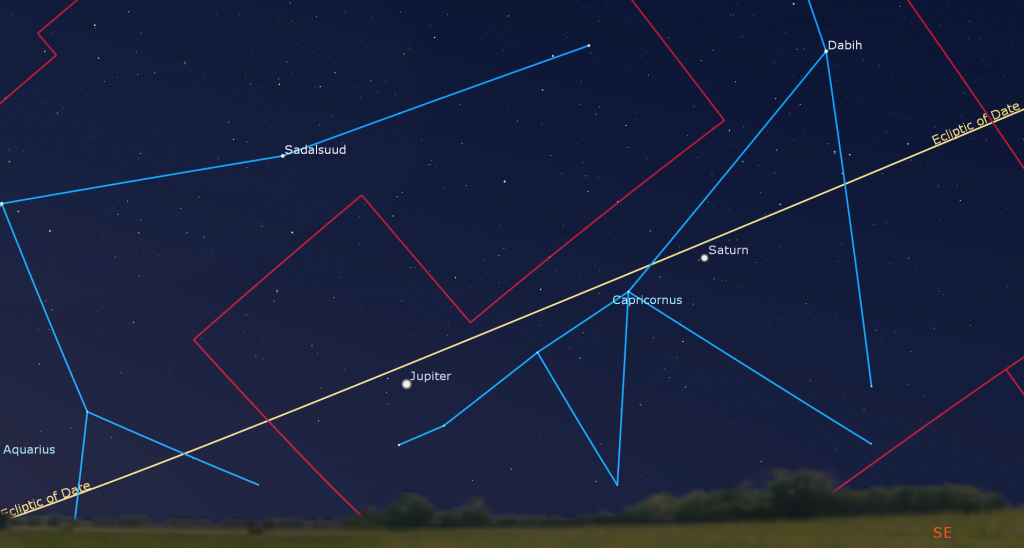
Uranus, Neptune, Mercury, and Venus are all too near to the sun to be observed. Venus passed the sun at superior conjunction on Friday, so that bright planet will become visible in the western sky after sunset starting next week. Mercury will join Venus there toward the end of April.
A New Star!
Astronomers have been excited by the sudden appearance of a nova in the W-shaped constellation of Cassiopeia (the queen). After its discovery on March 18 it has brightened enough to become visible in binoculars from the GTA. It’s located near the boundary between Cassiopeia and Cepheus (the King). It’s relatively low in the north-northwestern sky after dusk. But, because that part of the sky is circumpolar and never sets for the GTA, the nova will also be visible before dawn.
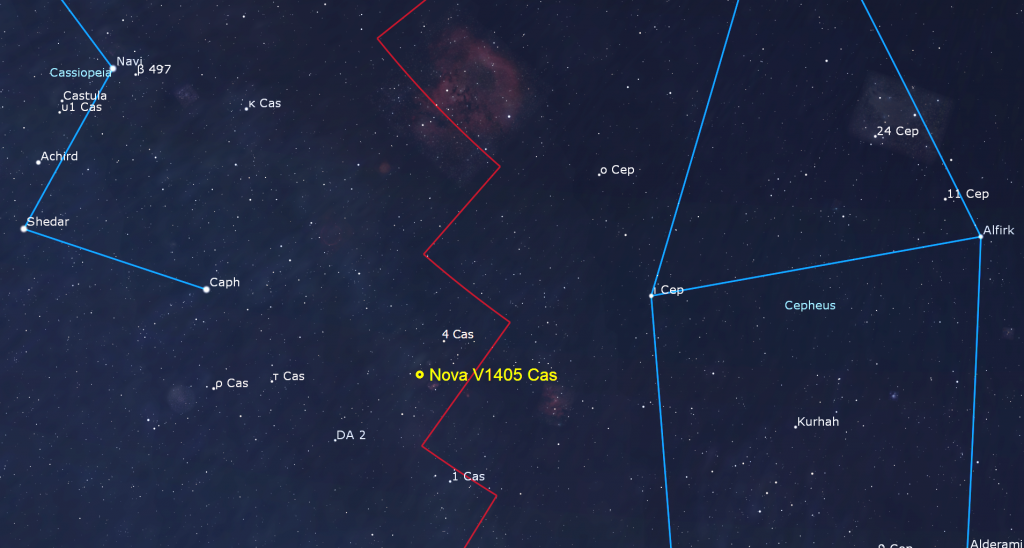
The nova is shining at about magnitude 8.0 now – that’s too faint to catch your unaided eye, but several brighter nearby stars can guide you to the nova. If you draw a line from the bright star Shedar to another named Caph, and double its length, you’ll be close to the right spot. Those stars form the outermost side of the deeper “V” in Cassiopeia.
A nova (Latin for “new”) is the sudden rapid brightening of a star (often previously unobserved) that occurs when two closely orbiting binary stars transfer gases from one to the other, and the buildup of the extra material causes a runaway nuclear fusion reaction and energy outburst. After reaching maximum brightness the nova will fade, but astronomers will watch it for months, and possibly years, because it could flare up again someday.
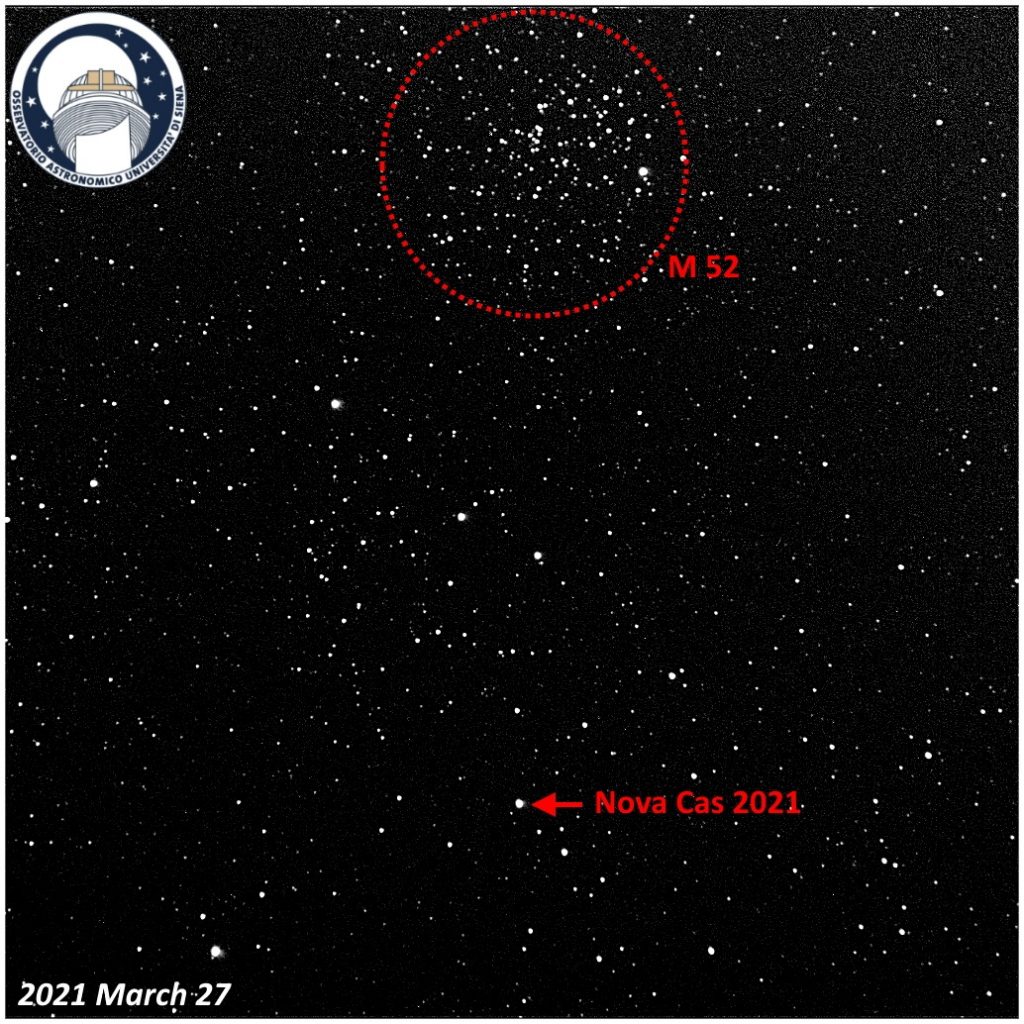
The Lion Leads Galaxies into View
The bright moon’s departure from the evening sky worldwide this week will open galaxy-viewing season! That’s a roughly two month window when the Milky Way drops to the horizon, leaving the evening sky overhead free of its obscuring gas and dust, and letting us peer into the deep Universe!
The best places to find galaxies are between the constellations of Leo (the Lion) and Virgo (the Maiden), and the constellations above them, Coma Berenices (Berenice’s Hair), Canes Venatici (the Hunting Dogs), and Ursa Major (the Big Bear). That’s because the point on the celestial sphere that points directly out of our Milky Way galaxy’s disk is located in Coma Berenices. To better acquaint you with the sky, let me introduce you to Leo, the Lion. I’ll talk more about galaxies next week.
For millennia, sky-watchers have imagined the stars in the night sky linking into patterns – forming humans and animals and inanimate objects. We call these groupings constellations, after the Latin for “stars grouping together”. Each culture has assigned their own spin on the heavens, usually naming the patterns after things in their everyday experience. For example, south sea islanders saw outrigger canoes, and the Inuit saw the Big Dipper as the Caribou and Cassiopeia’s “W” as the Blubber Container with a Lamp Stand nearby.
In modern-day astronomy, the entire sky is divided into 88 officially recognized constellations. The manner in which the stars are connected into stick figures is not regulated, but the boundary lines between the constellations is. That way, there are no gaps in the coverage, and every object in the heavens can be placed within one of the 88 regions. By the way, astronomy has a long tradition in China – and they connected smaller groups of stars, yielding several hundred Chinese asterisms or 星官, xīngguān.
A handful of constellations are so obvious that many independent cultures assigned the same figure to those stars. A perfect example of this is the spring constellation of Leo (the lion). The lion was identified as early as 1000 BCE by the Babylonians, and later by the Egyptians, Greeks, and Romans. To the Greeks it represented the Nemean Lion slain by Hercules during his labours. Only that beast’s own claws were sharp enough to slice its hide.
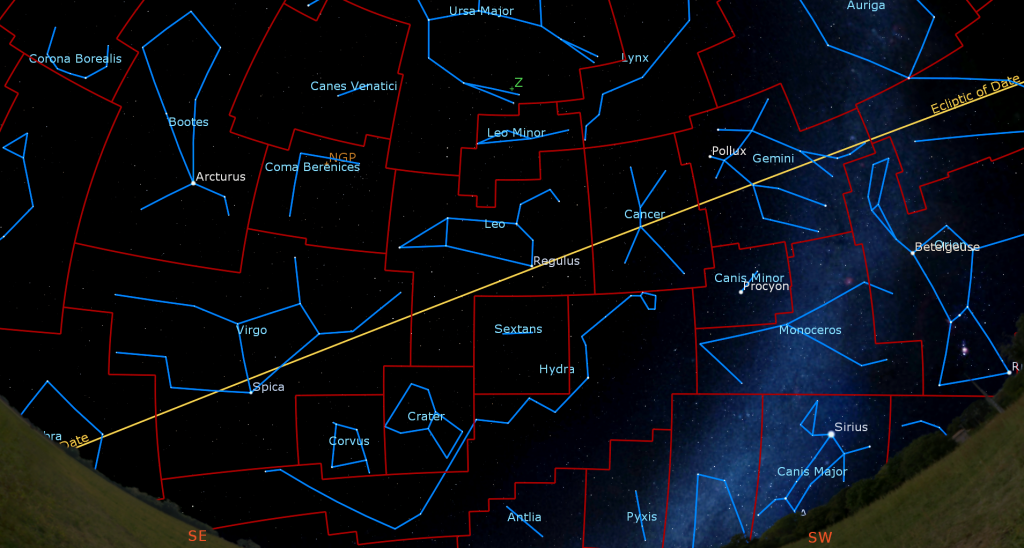
It’s easy to find and recognize Leo, even from suburban skies. Head out on the next clear evening and face the south. Leo is a large constellation situated more than halfway up the evening sky, and just above the imaginary Ecliptic line which the Sun, Moon, and planets all move along. For this reason, Leo is one of the twelve Zodiac constellations. He is positioned with his head facing right (west) and his tail towards the left (east). He has no legs or feet. Like most lions, he’s got them tucked underneath himself!
The lion’s brightest star is Regulus. Regulus means “Little King” in Latin and its Arabic name Qalb Al Asad translates to “the heart of the Lion”. A blue-white star with a visible small companion star nearby, Regulus is the 21st brightest star in the heavens. Its position very close to the Ecliptic causes it be occulted frequently by the moon and the inner planets.
From Regulus, look upwards and trace out another five modest stars forming a backwards question mark, or sickle, about 1.4 fist diameters tall. This represents the lion’s neck, head, and mane. The second star up from Regulus is another reasonably bright star named Algieba, or “the forehead”. In a backyard telescope, Algieba splits into a very pretty pair of yellow stars, one slightly brighter than the other.
From Algieba, cast your gaze a bit more than fist’s width to the left to find a star of similar brightness named Zosma, situated at the lion’s hip. Then, angling down and to the left another fist’s width, we find a star at the lion’s tail, Denebola, the second brightest star in the constellation. Denebola is a young star only a few hundred million years old. It emits quite a bit of infrared radiation, suggesting that this young sun may have a planet-forming dust disk around it.
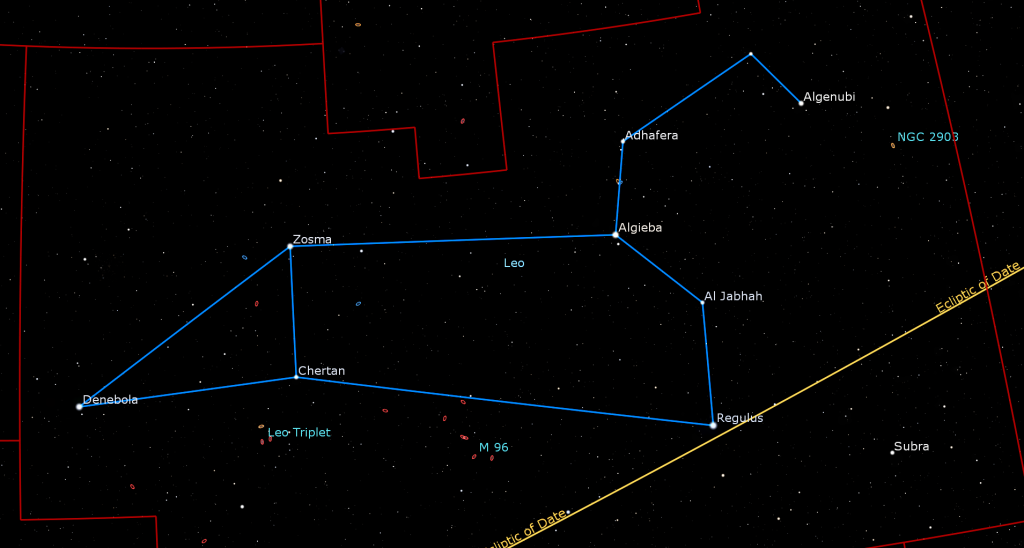
The last major star of Leo, named Chertan, sits to the lower right of Zosma and Denebola. Those three stars form a nice triangle. This is where things get interesting! Leo is a favorite of amateur astronomers because it contains a nice selection of relatively nearby and bright galaxies.
Draw a line from Zosma to Chertan and, about two finger widths farther from Chertan is found a famous set of three spiral galaxies known as the Leo Triplet. When viewed from a dark sky location, all three galaxies (two of which are on Charles Messier’s list, namely M65 and M66) can be framed in a good telescope at low magnification. Another sprinkling of galaxies is located midway between Chertan and Regulus, two finger widths below the line joining the two stars. This group contains M95, M96, and M105 – plus another non-messier galaxy. And that’s just the beginning – the patch of sky located about a fist’s diameter to the rear of Denebola contains dozens of bright galaxies! But that’s another story…
Now that you see the lion – can you see the mouse? It’s easy to imagine the sickle of stars as a mouse’s curly tail, and Denebola as the mouse’s nose!
Public Astro-Themed Events
Every Monday evening, York University’s Allan I. Carswell Observatory runs an online star party – broadcasting views from four telescopes/cameras, answering viewer questions, and taking requests! Details are here. Their in-person Wednesday night viewing has been converted to online via the observatory YouTube channel, where they offer free online viewing through their rooftop telescopes, including their 1-metre telescope! Details are here.
On Monday afternoon, March 29 at 1:30 pm EDT, The Origins Institute at McMaster University will present an online lecture entitled Searching for Life Beyond Earth by Dr. Nathalie A. Cabrol, Director, SETI Institute Carl Sagan Center for Research. Details and the registration link are here.
My free, family-friendly Insider’s Guide to the Galaxy webcasts with Jenna Hinds of RASC National returns on Tuesday afternoon, March 30 at 3:30 pm EDT. We’re going to talk about the Aurora Borealis (and Australis)! You can find more details, and the schedule of future sessions, here and here.
On Thursday, April 1 from noon to 12:30 pm, RASC National will launch their new weekly moon-observing series the Moon at Noon featuring Jenna Hinds and guests. Details are here and the registration link is here! Sessions will also be livestreamed to YouTube here and can be watched at any time.
On Sunday afternoon, April 25 from 1 to 2 pm EDT I’m hosting an online session for RASC called Ask an Astronomer! We’ll explore the night sky together and answer your astronomy and space-related questions in simple language – using pictures, illustrations and planetarium software. The deadline to register is Friday, April 23 at 3:00 pm. Registration is here. A modest fee goes to support our ongoing efforts to deliver public programs at DDO.
Keep looking up, and enjoy the sky when you do. I love questions and requests. Send me some!